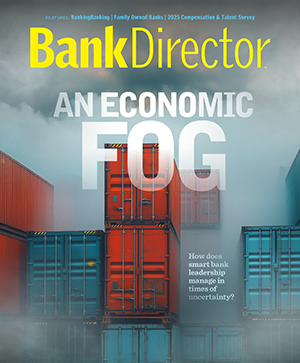Chantel Shipe is Vice President of Strategic Planning at FIS, where she leads transformative initiatives across Core Banking Solutions, guiding teams to execute on strategic goals and drive customer-focused growth. With over 23 years in the financial services industry, she has built strategies that elevate brands, deepen client relationships, and help deliver double-digit revenue growth. Chantel is known for her expertise in strategic messaging, product enablement, and innovation, including new product launches. She holds a degree in Mass Communications and Journalism from Belmont University and completed executive training at Dartmouth’s Tuck School of Business. Chantel has also served on the board of Kids on the Go since 2018, reflecting her commitment to community and is an advocate for compassionate leadership.

The Ups and Downs of Bank M&A
A pursuit of scale, innovation and efficiency has banks increasingly looking to M&A to grow. Uncover the benefits and risks, and how boards can drive a successful transaction.
Brought to you by FIS

Banks are seeing renewed M&A momentum. Evolving regulatory attitudes and stable valuations make stock-based deals more attractive, leading to cautious optimism in C-suites that M&A is back on the table as a growth strategy heading into 2026. Acquisitions also offer an alternative route to boost earnings, but M&A is equally driven by margin pressures, rising costs and economic uncertainty.
The Exploring M&A trends and challenges in banking survey, conducted by the marketing company TechStudio and FIS in April 2025, found that most bank executives feel positive about their M&A prospects, with 54% saying their bank aimed to complete an acquisition within the next 12 months. Notably, roughly 61% were looking to acquire or merge with another institution compared to only 12% seeking to be acquired. The survey draws insights from 300 executives responsible for enterprise-wide transformation and growth, along with key stakeholders in lending, operations and compliance at North American banks with over $1 billion in assets. Many of the respondents revealed they have experience to draw on — a majority have engaged in M&A before.
M&A offers a number of strategic benefits for banks, including scale and efficiency gains, cost efficiencies and market share improvement. Mergers can quickly increase assets and geographic reach, and spread compliance and technology costs.
Many view M&A as a fast track to acquire modern capabilities. In the survey, 40% of bank executives cited technology improvements as a top post-merger goal. Acquired tech stacks or niche products can be leveraged across a combined entity, helping upgrade customer experience and back-end efficiency more quickly than building in-house.
Acquisitions offer quick entry into new markets or customer segments. A community bank might merge with a peer in a neighboring state to broaden its footprint or acquire a firm with complementary lines of business to diversify revenue. Strategic expansions can drive growth beyond organic efforts, an attractive proposition for boards looking to boost long-term shareholder value.
While the upside of M&A is clear, bank directors should be aware of the risks and pitfalls. Overestimating synergies can lead to overpaying for a target, causing value destruction if anticipated savings or revenue enhancements fall short. Directors should demand conservative estimates and consider contingent payouts tied to post-acquisition performance. Maintaining discipline on price and having a clear integration road map are crucial to achieving promised efficiencies, and rigorous due diligence can help banks avoid costly surprises post-merger.
A deal that looks good on paper can falter in execution, and combining two banks’ systems, processes, and cultures is complex. Technology integration, including data migration and testing, is often the biggest hurdle. Merging core banking systems and online platforms can disrupt customer service if not executed flawlessly. Cultural integration is also critical, as differences in company culture or management style can affect employee morale and productivity. Boards should have a detailed integration plan covering IT, personnel, products and branding well before Day 1 of the combined entity.
Even well-planned mergers can be disrupted by external events like economic downturns, interest rate changes or shifts in investor sentiment. About half of the bank executives surveyed identified financial instability as the top risk to M&A outcomes. Boards should have contingency plans for adverse scenarios and ensure the pro forma bank has healthy capital buffers to withstand economic volatility.
Thorough preparation and oversight are key to a successful merger. Boards and executives should ensure deals have clear strategic rationale and long-term goal alignment. Due diligence on technology, culture and the loan portfolio should be rigorous, and a detailed integration should be prepared early on, especially for IT systems and key personnel roles. Maintain open communication with employees, customers and regulators, and monitor post-merger performance closely. Encouragingly, 72% of survey respondents had analyzed potential cost savings in advance, helping them to be prepared for a successful integration. Such foresight can help surface challenges early.


